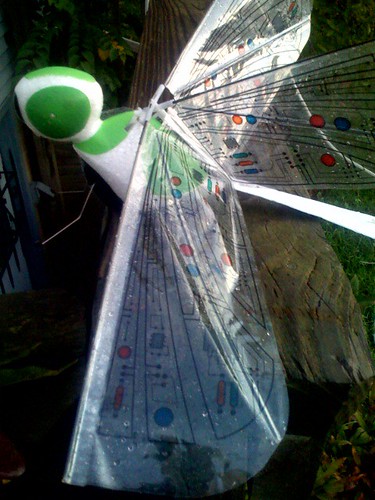When highschoolers Sean Frawley and Dan Getz wanted to make a ornithopter from a kit, they found few models for sale — so they made their own. After selling rubber-band powered dragonfly and swallow ornithopters on their web site, they were featured in a 2002 issue of Popular Science, generating enormous publicity for their projects. Eventually Frawley & Getz sold their dragonfly kit to WowWee which marketed the final product as the FlyTech Dragonfly.

 For those who don’t know, an ornithopter is a flying machine that flaps its wings like a bird, from the Greek ornithos (bird) and pteron (wing). The term is also used for any heavier-than-air vehicle that moves by flapping wings, even if the precise mechanics don’t resemble those of a bird. As to whether the FlyTech Dragonfly is the first RC ornithopter, or is in fact an ornithopter at all, I’ll leave to quibblers. (It should be noted that WowWee refers to the product as a RC “flying insect” thus side-stepping the debate altogether.)
For those who don’t know, an ornithopter is a flying machine that flaps its wings like a bird, from the Greek ornithos (bird) and pteron (wing). The term is also used for any heavier-than-air vehicle that moves by flapping wings, even if the precise mechanics don’t resemble those of a bird. As to whether the FlyTech Dragonfly is the first RC ornithopter, or is in fact an ornithopter at all, I’ll leave to quibblers. (It should be noted that WowWee refers to the product as a RC “flying insect” thus side-stepping the debate altogether.)
There really hasn’t been much success in the ornithopter front. Think of those goofy monochrome movies we saw as kids showing all the failed attempts at inventing flying machines (usually with the bowler-hat-wearing tinkerers wiping out hilariously.) The The Ornithopter Zone lists the most successful flights of manned, motorized ornithopters as having taken place in 1942 and 1947. In 2005 a Frenchman named Yves Rosseau managed a 64-meter flight and on his very next attempt smashed up his craft. Which is not to say there’s not a huge amount of interest in the concept. The military, they say, wants ornithopter drones dressed up as pelicans. (With an AGM-114 under each wing to scrag evildoers?)
The Dragonfly, however, most certainly does fly. In fact, it flies a lot like a real dragonfly, gliding gently then darting quick. Even on “beginner” mode it isn’t easy to control. Better to fly it outside on a windless day — the craft is so light it can be blown out of range by a strong gust. Hummingbird-light, it seems too fragile to hold up to the inevitable crashes, but its weight is a benefit — it bounces rather than damaging itself or whatever it impacts. It won’t break a window or a vase. The most fragile parts are the tail rotor and cellophane-ey wings, but spares accompany the model. A full charge will get you 10 or more minutes of flapping, it recharges directly from the controller’s six AAs.
While the gadget has only been around for less than a year, already people have begun to hack it. Swapping in lower voltage LEDs to save power, upgrading the Li-ion battery packs, and upping the controller’s wattage to expand the unit’s 50-foot range. But the thing is still fun to fly as-is. By the time the first charge was drained, I was swooping all over the yard, dive-dombing the snapdragons.
